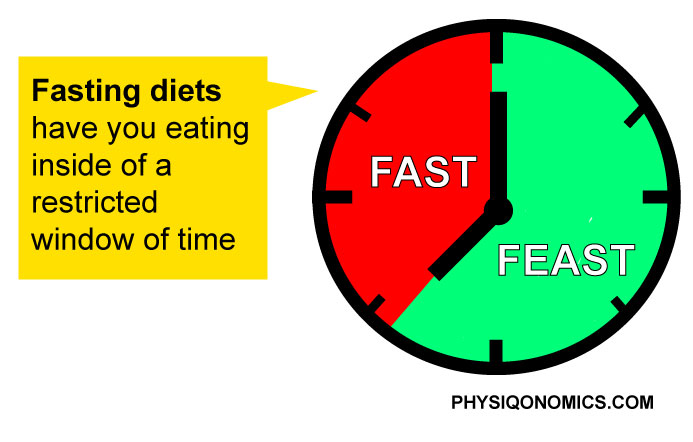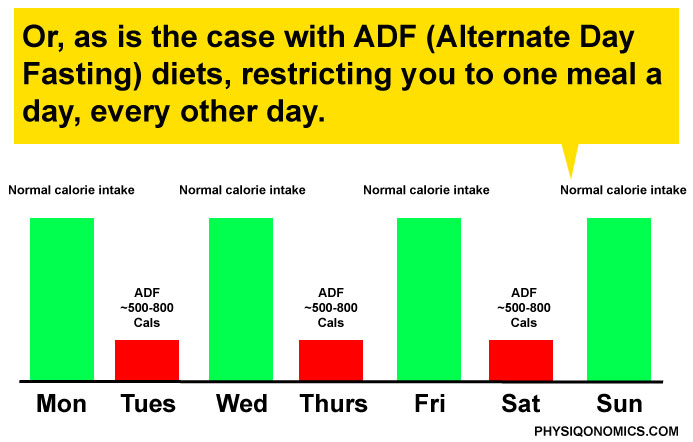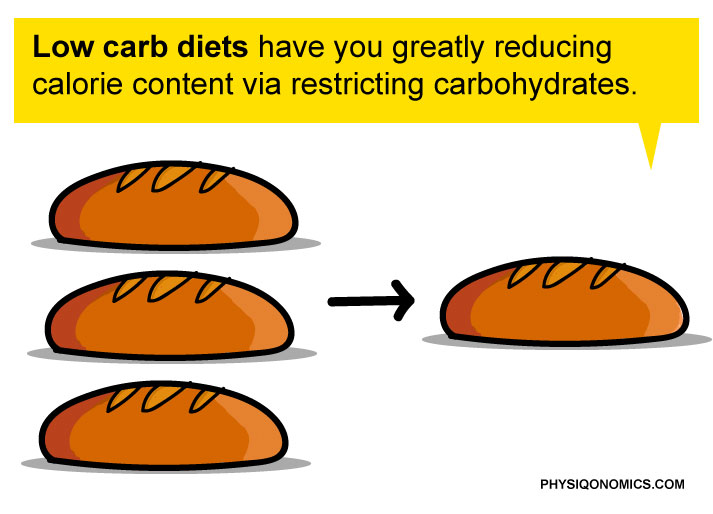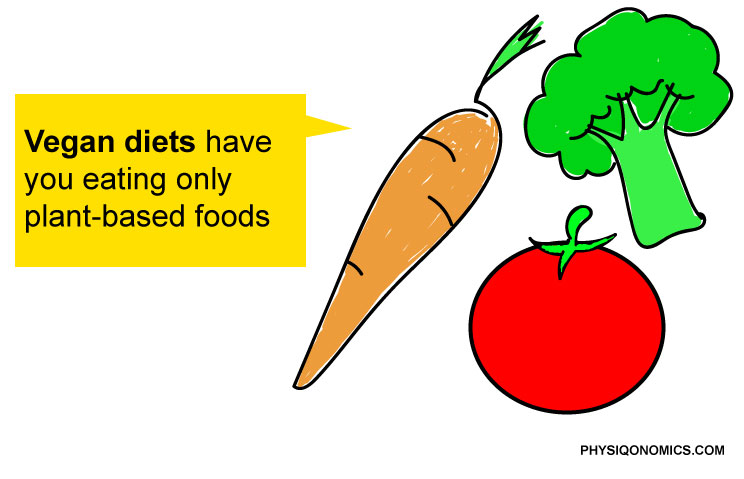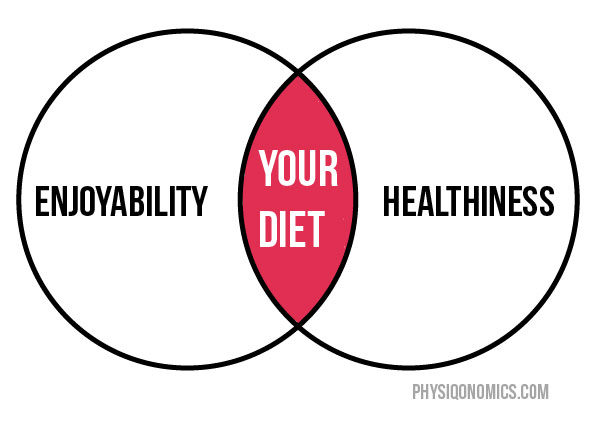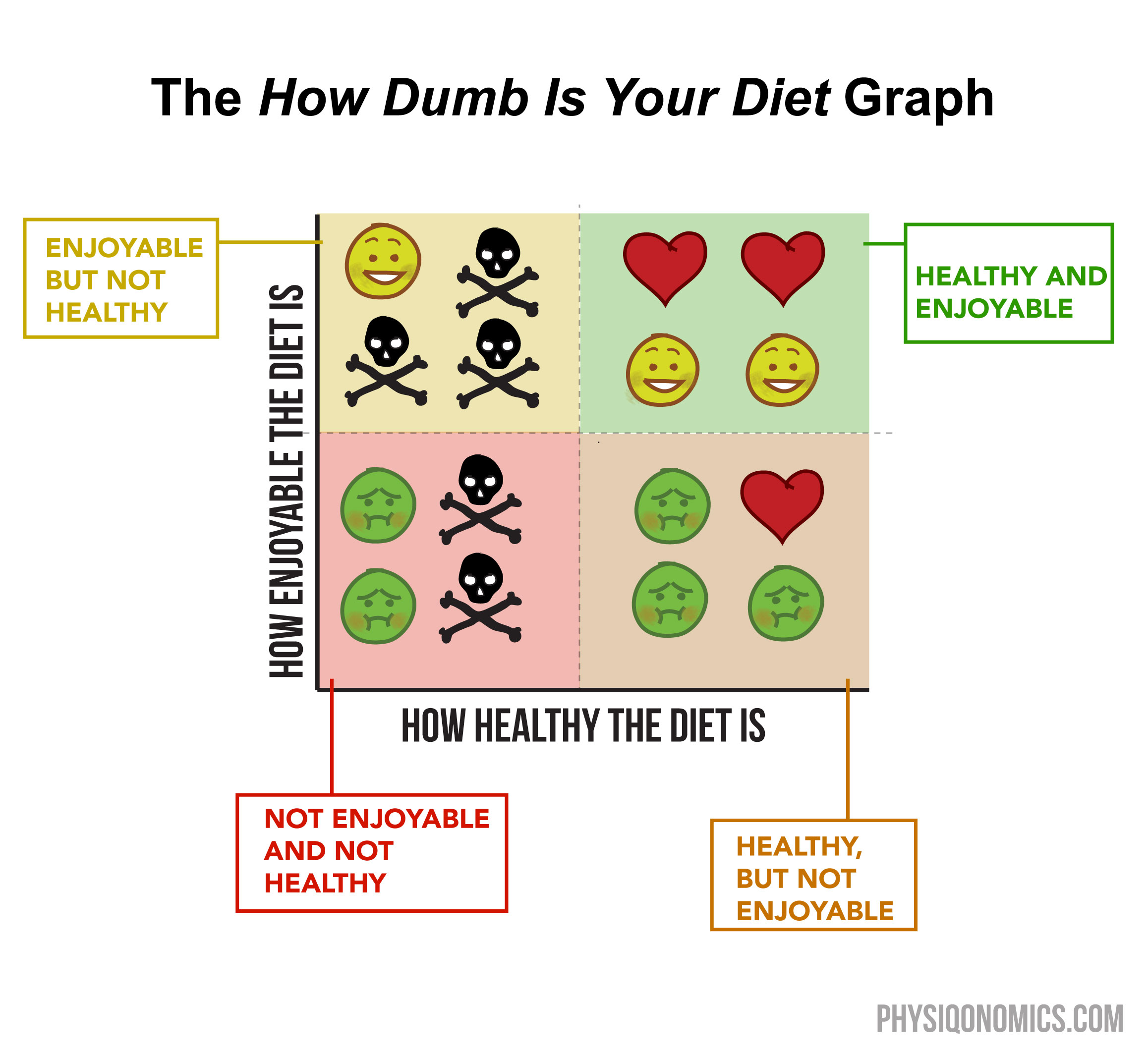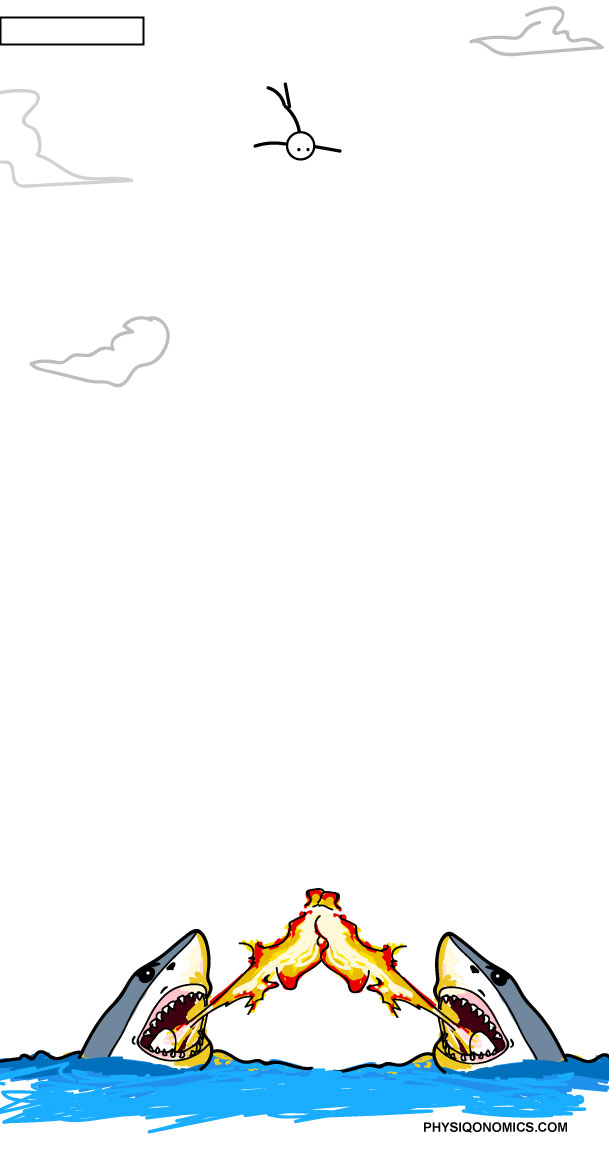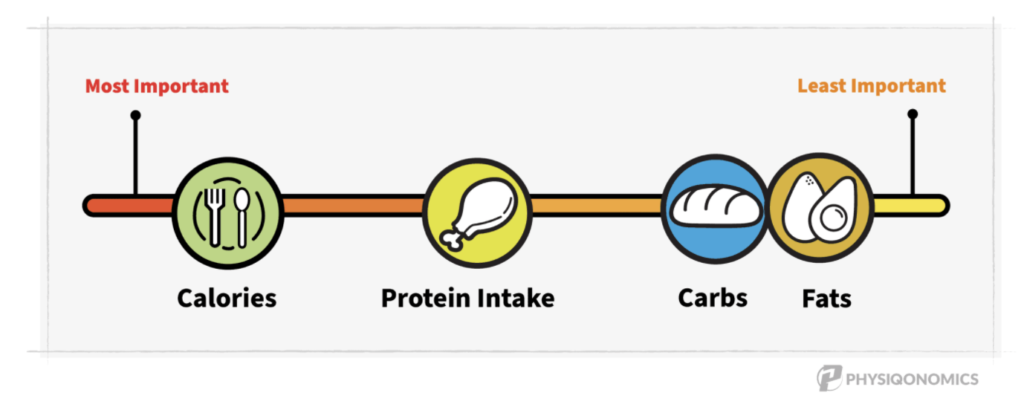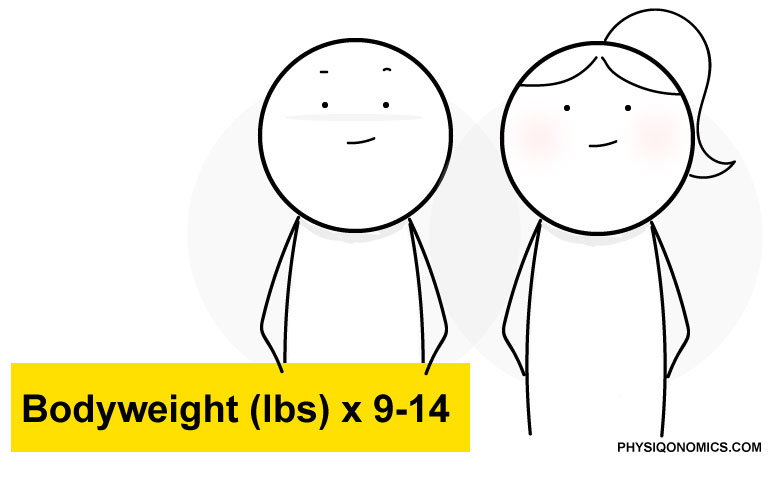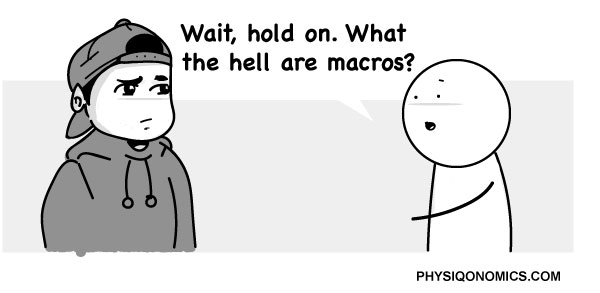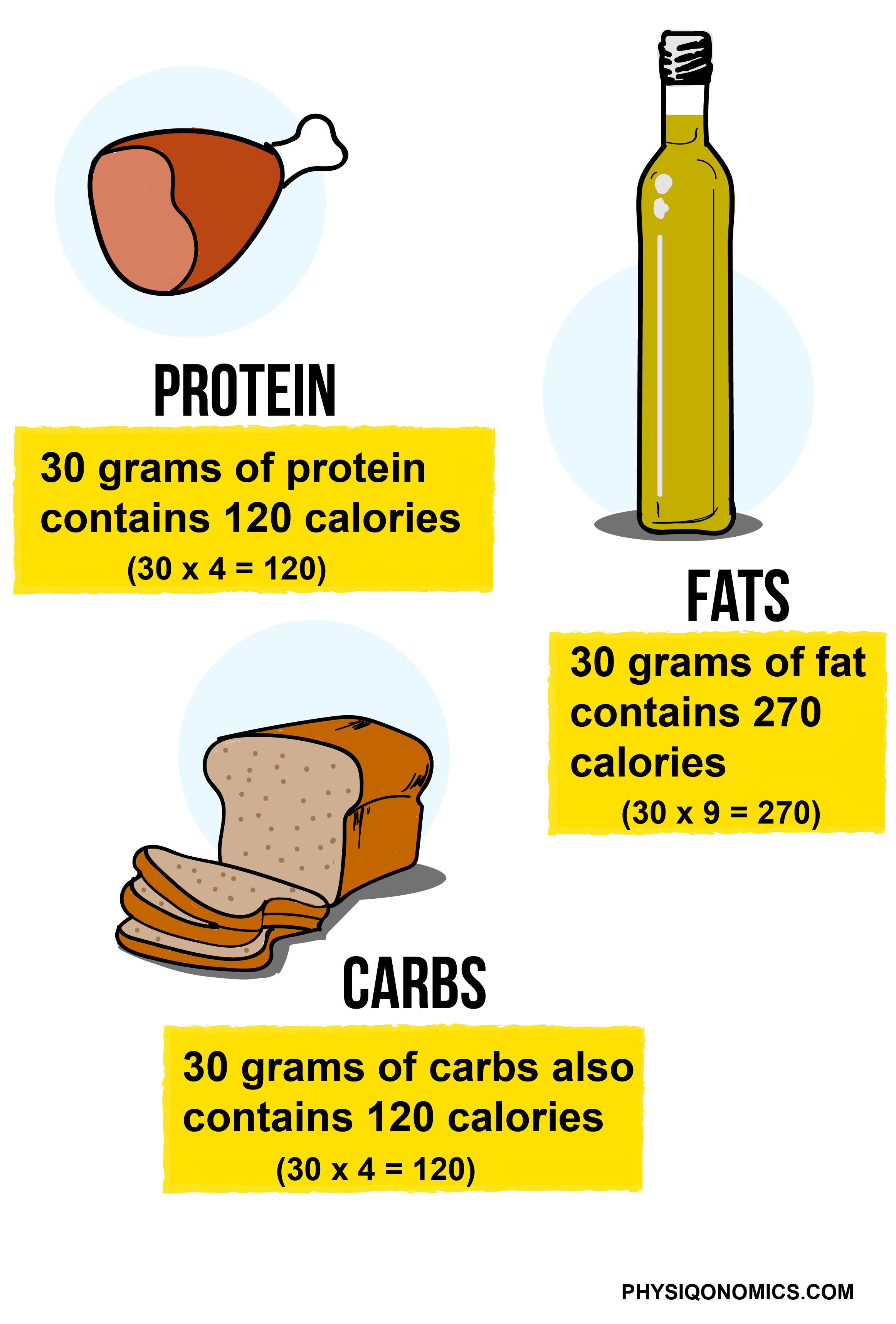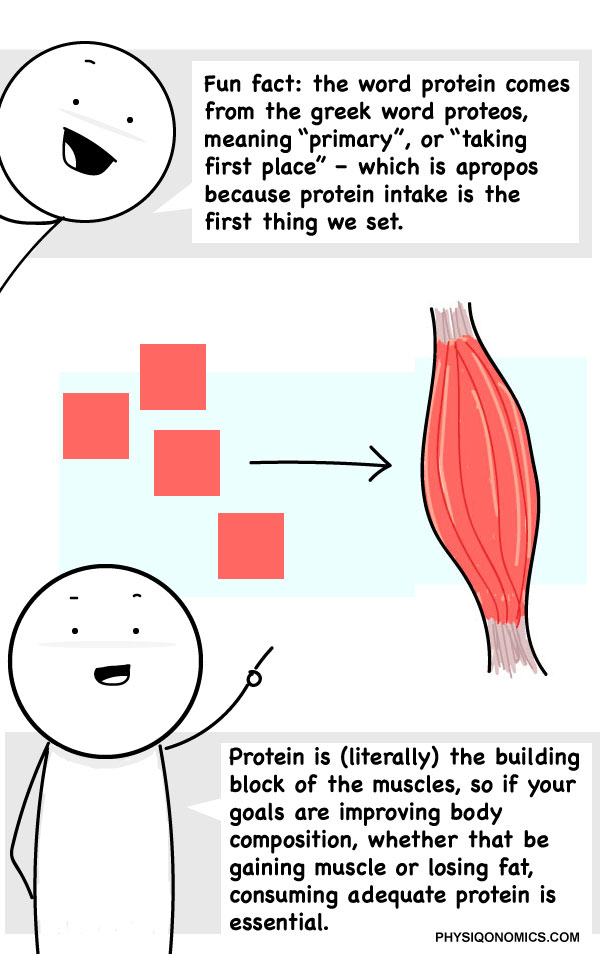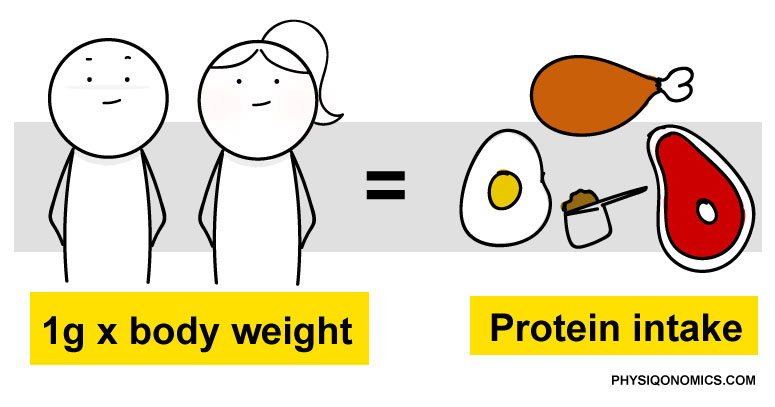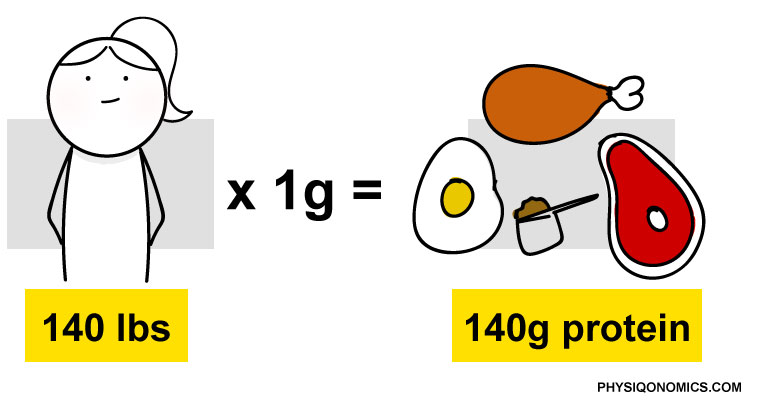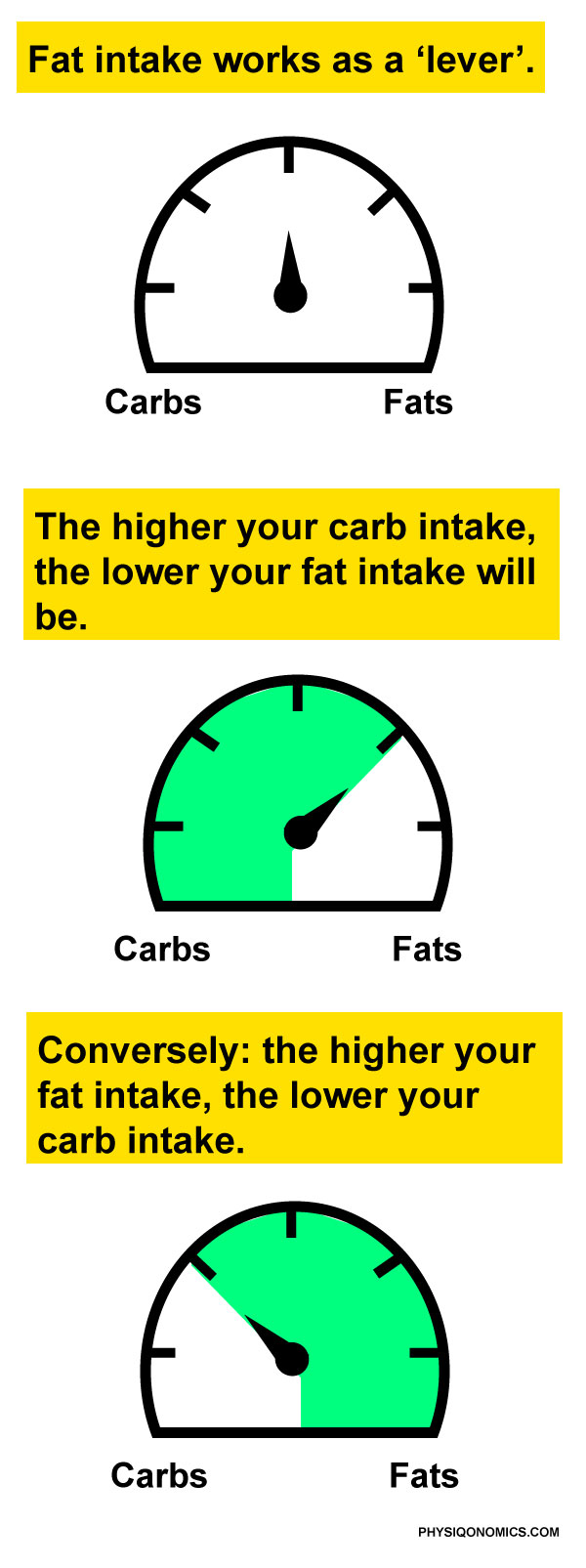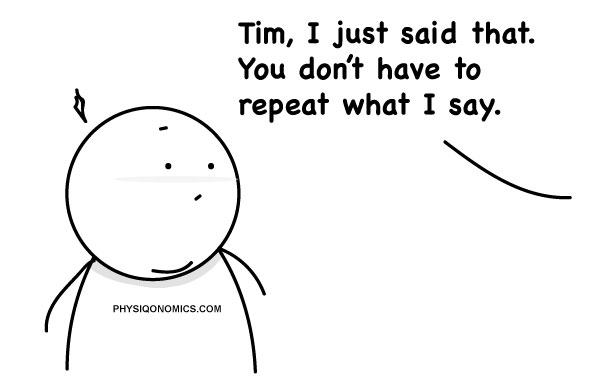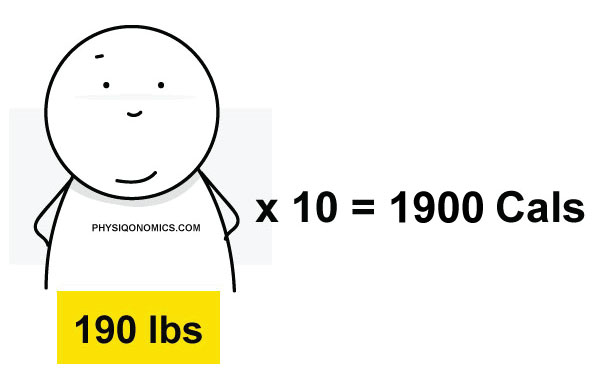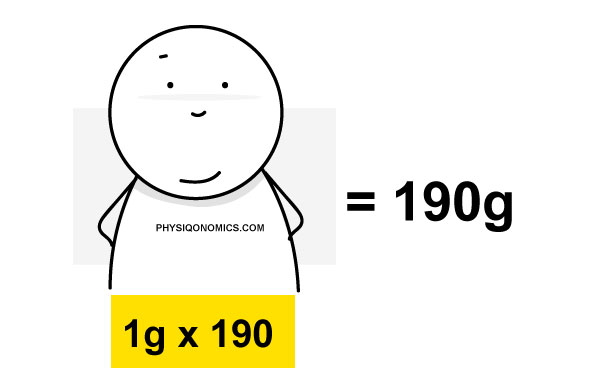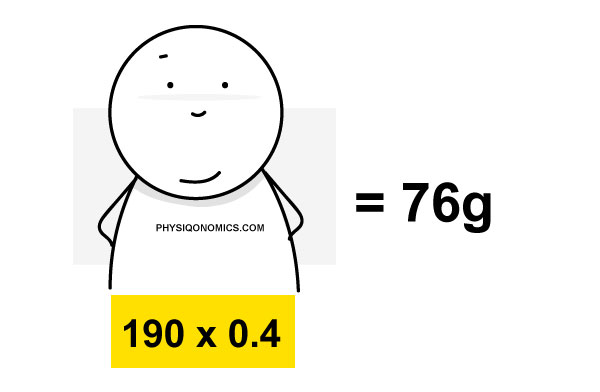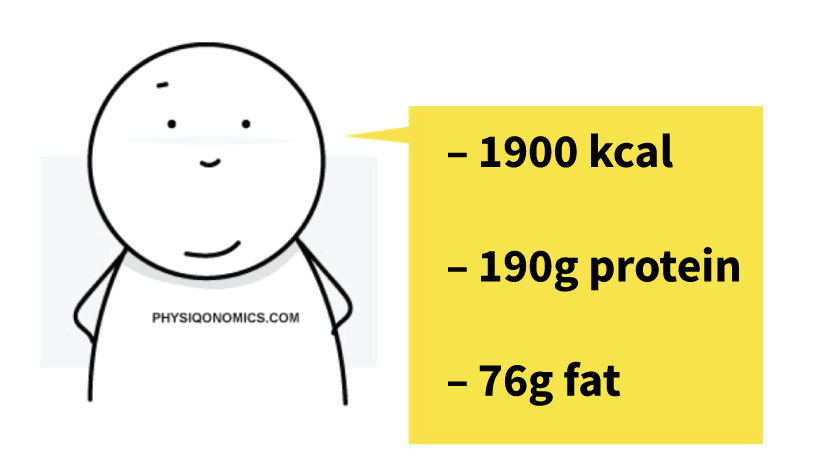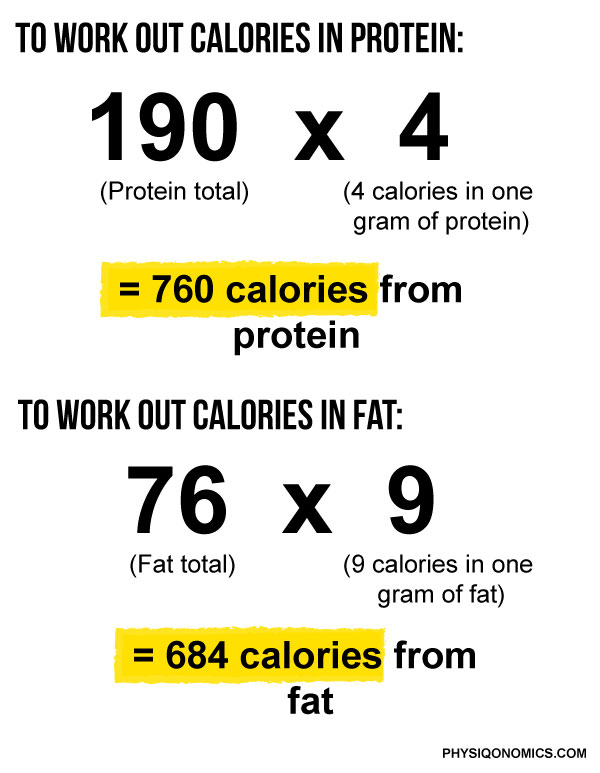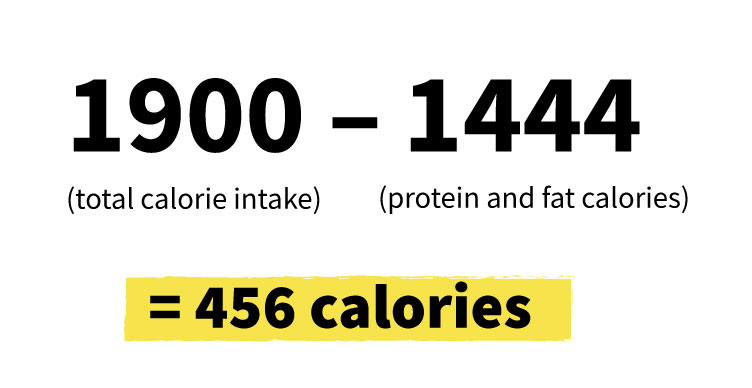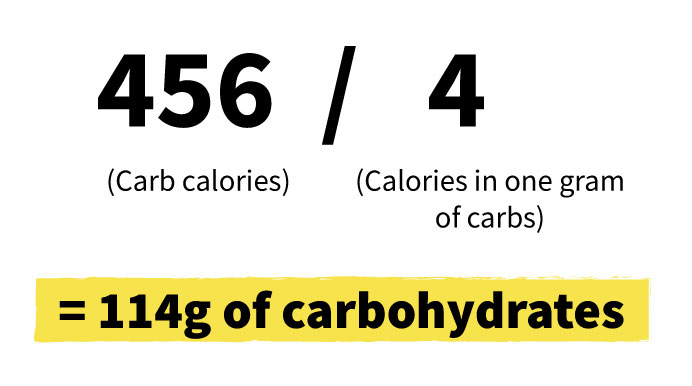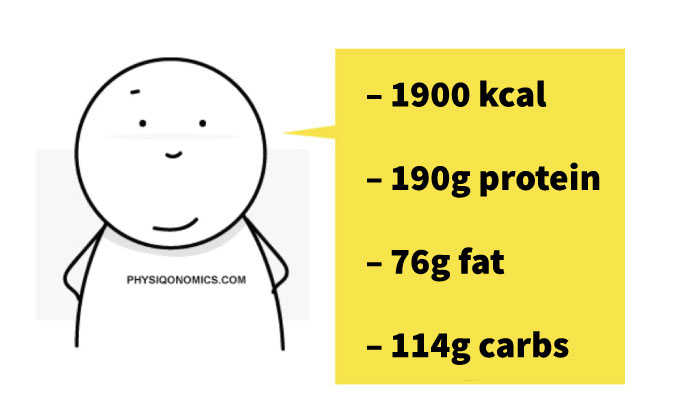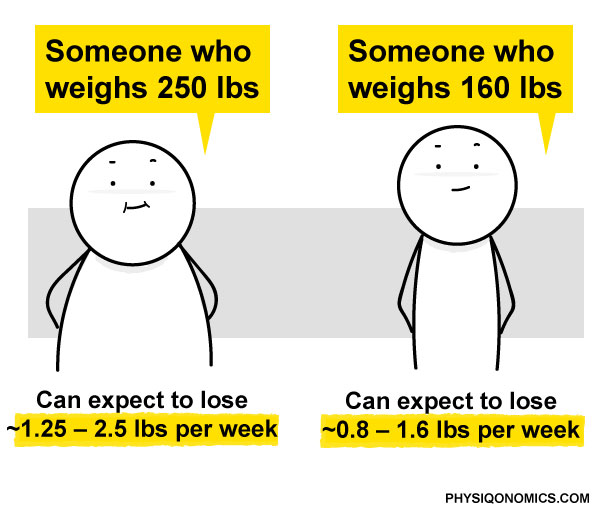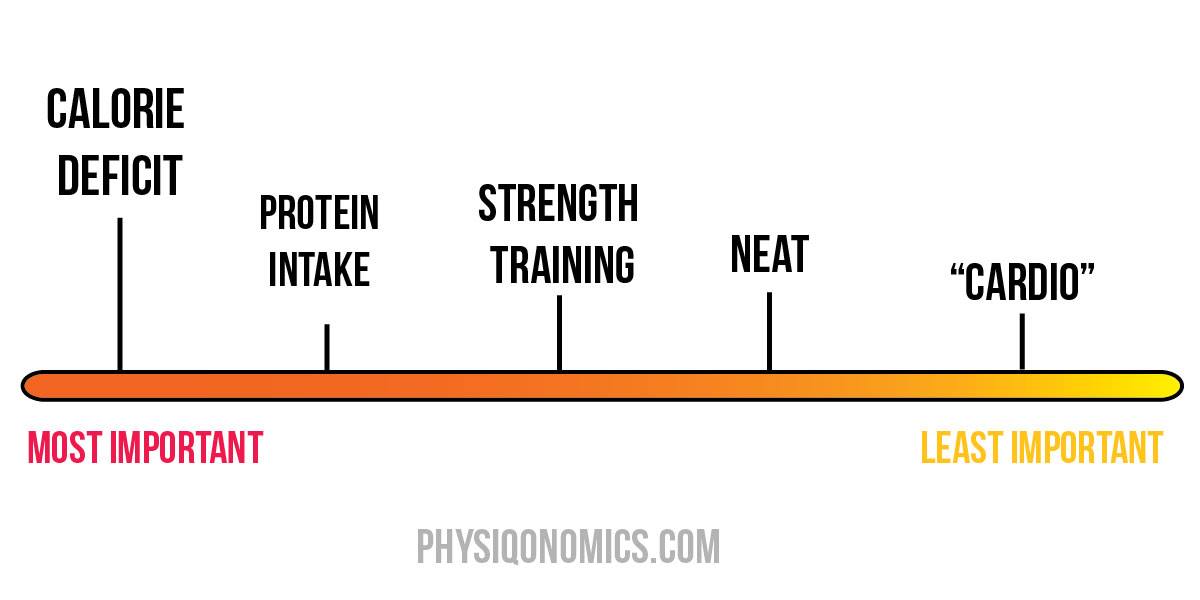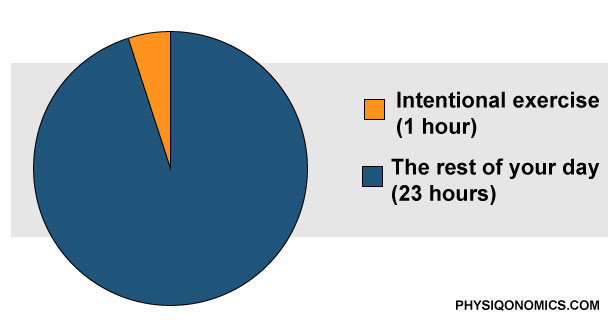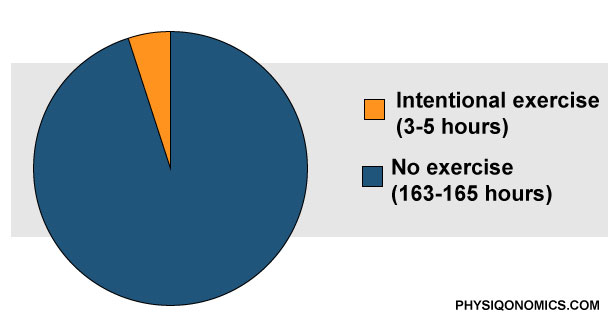There’s an unwavering deluge of fat loss information out there. Shakes, pills, potions, One Weird Tricks, and a bunch of other bullshit. This is the last fat loss article you’ll ever need to read. You’re welcome.
You can download this article for offline viewing as a free pdf. Pop your best email address in the box below and click the shiny red button. I’ll also send you a beginner strength program.
• Read the child-friendly version of this article here. I appreciate this is one of those things you’d want to share with your kids so they grow up smart and not have to resort to selling protein shakes on Instagram. So, to ensure the spreading of good information, the continuity of our species, and the well-being of your children: you can also read this article without all the cursing.
• Grey footnotes, like this guy → 1 are study citations and references. These are the boring footnotes reserved for the nerds who want to read the papers.
• Red footnotes titled ‘Aa’, like this guy → Aa are extra thoughts or a further explanation of something I mentioned.
But first
This is the part where every other fat loss article gives you a virtual blowie telling you why it’s not your fault, why it’s all going to be okay with this one simple trick, and why you’re a special snowflake who just needs to think happy thoughts and click your heels so you feel justified reading it. Well, guess what?
That’s bullshit because it IS your fault.
If you’re unhappy with your weight, or your body, for whatever reason, that’s your problem. The sooner you accept this, the sooner you’re going to start making progress.
You can read all the “TOP 10 FAT LOSS HACKS YOU AREN’T DOING” articles you want, or stare at motivational quotes by some famous dead person plastered across a pair of random abs or glutes, but until you realise change depends on getting off your ass and doing something, nothing’s going to happen because your fat loss is down to you actually wanting to make a change.
And seeing we’re here now: I get gazillions of emails and questions from people asking me for the solution to their lack of motivation–well, fuck you. There is no solution.
Did I hurt your feelings? Well, fuck your feelings.
Here’s what nobody tells you about motivation: the more you look for motivation, the less motivated you become because you don’t do anything.
Action begets motivation.
And unless you–yes, you–don’t start taking the steps toward making a positive change, no other person or thing can help.
If this isn’t what you want to hear, then feel free to close this page and go back to living in denial.
For those of you who are ready to accept this and want to make a change, let’s get started. Aa
Table of contents
- The dirty secret of the diet world
- Considerations for picking a diet
- Setting up your diet
- What should you eat?
- What about supplements?
- Making adjustments to the diet
- How fast can you lose fat?
- Training for fat loss
- The FAQ
HERE’S THE DIRTY SECRET OF THE DIET WORLD: EVERY DIET WORKS
Don’t believe me? Fine. Let me drop some facts on your face.
In 1964 a group from the Institute for Medical Research in Oakland, California, set out to study the impact of different macronutrient compositions on weight loss in obese patients.
The study involved five obese patients residing in a hospital metabolic ward.
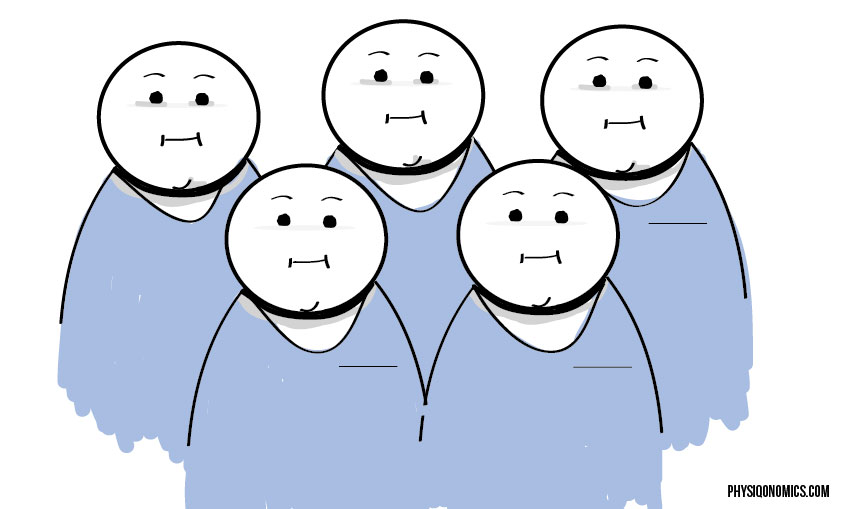
The patients were fed a liquid formula diet containing the same number of calories per day–either 800, 850, or 1200 (depending on the patient)–for ten weeks.
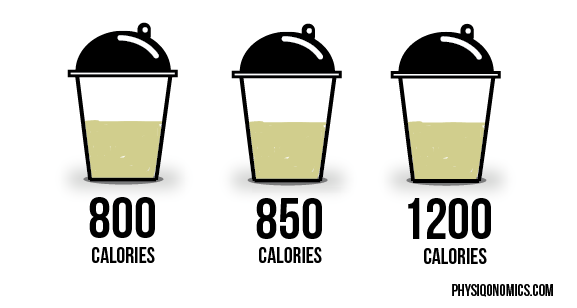
Every three or four weeks the investigators changed the formula to vary its content of protein (from 14% to 36% of calories), fat (from 12% to 83% of calories), and carbohydrates (3% to 64% of calories).
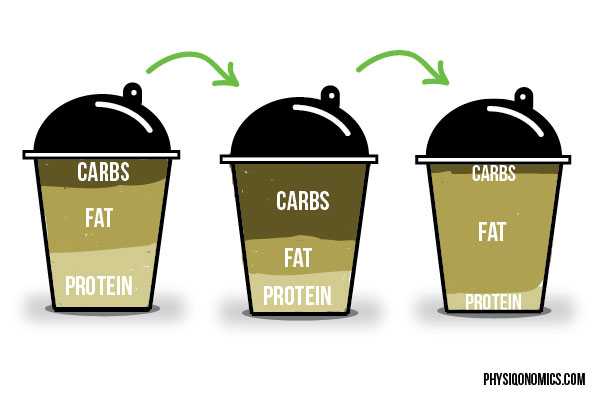
All of the obese patients lost weight at a constant rate, regardless of the nutrient composition of the diet. What mattered was the total calorie deficit.
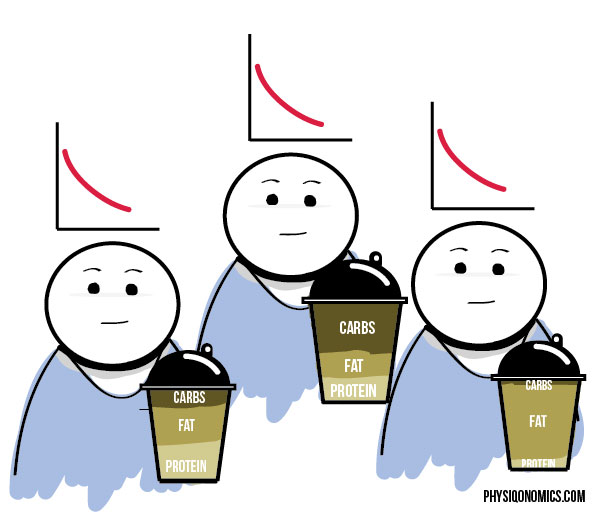
The title of the study was eponymous to the findings: Calories Do Count 1
A similar experiment was done in 2009, with researchers concluding:
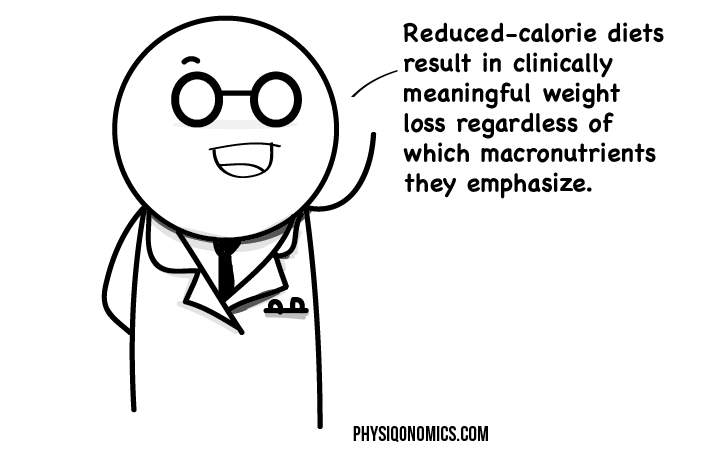
All diets work because of the same mechanism: reducing your calorie intake.
You get the idea.
People don’t fail with diets, people fail to maintain a diet for the long-term.
And the biggest reason why is because they fall for nonsense like juice cleanses, or adding butter to coffee because apparently butter is a fucking health food now (spoiler: it’s not). Or any of the smorgasbord of weird and wacky dumbfuckery that’s rampant in the diet world.
If you want to be successful with your fat loss, find a diet you enjoy and can stick to. Here are some considerations that will help you do just that.
CONSIDERATIONS FOR PICKING A DIET
After much thought and deliberation on the topic, I’ve noted two things that every good diet should have: Enjoyability and healthiness.
But, there needs to be an equal amount of enjoyability factor to its healthiness factor otherwise the diet is dumb. We can represent this with the How Dumb is Your Diet graph.
The graph has four quadrants, so let’s take a look.
• Quadrant 1. Enjoyable but not healthy: This is the prototypical Standard Western Diet–high fat, high carb, high calorie, high everything. It’s highly enjoyable but about as healthy as bungee jumping without the bungee into a pit of fire breathing great white sharks.
• Quadrant 2. Healthy but not enjoyable: This is when you eat in a way you don’t enjoy but think it’s the only way and is the direct opposite of the above. It doesn’t matter how healthy a diet is if you don’t enjoy it.
• Quadrant 3. Not enjoyable and not healthy: This is the mystical realm of what I like to call “Dumb Fucking Shit”. And it’s where things like juice cleanses and coffee enemas (no, really, this is a thing) reside. Like Mufasa told Simba: Stay the fuck away from there.
• Quadrant 4. Healthy and enjoyable: This is where you want to be. You’re eating a diet that provides you with a wide range of whole, nutrient-rich foods while allowing you to eat in a way you enjoy.
Understanding healthiness and enjoyability
It’s important to understand what I mean when I use the terms ‘healthiness’ and ‘enjoyability’.
Enjoyability
• Taste preference: Does your diet support your personal taste preference? If you enjoy fattier foods then your diet should account for that. If you enjoy carb-based foods, then you probably shouldn’t be using a ketogenic diet.
• Quirks: I didn’t know what to call this so we’re going with quirks. Do you enjoy higher calorie days? Or fasting? Or cycling calories? Then your diet should account for this.
• Autonomy/choice: The overall enjoyability of the diet will be predicated on whether it was your choice. (Refer back to quadrant 2 of the How Dumb Is Your Diet Graph).
Healthiness
We can break healthiness down to psychological and physiological health.
• Psychological
→ Restrictiveness: The biggest psychological factor is how restrictive your diet is. Now just to be clear, restriction is a necessity at times (a calorie deficit, for example, is a form of restriction) and there will be times when you’re going to need to be disciplined and restrict certain foods. But, this should only be for a short period of time and not how you should be eating all the time.
→ Personality Type: This sounds complicated, but it’s not. Simply put, your personal idiosyncrasies play an important role in how you set up your diet. I’ve noted that people generally fall into two categories:
▻ Moderators: Moderators are people who can moderate food intake. These are the people who can have a few bites and stop. These types of dieters do well with a much less rigid and more flexible approach. They thrive on the “IIFYM” based diets. They don’t have many trigger foods and can eat everything in moderation.
▻ Restrictors: restrictors are the polar opposite. They need a lot more structure and rules (and certain restrictions). These are the people who do well with removing certain foods if they cause bingeing or overeating.
• Must-haves: Must-haves are things that you absolutely must have in your diet or it’s a no-go. Now, don’t get me wrong, chances are that there will be some things you’ll have to remove if they’re going to impede your progress (like trigger foods); but generally, these will only amount to a small number of things, whereas the must-haves will be the overarching things, like certain foods, macros, etc. Must-haves will also include your work and life circumstances–do you travel? Are you sedentary/seated for large parts of the day? Does your job have odd work hours like working night shifts?
• Physiological
→ Calorie controlled: Of course calorie control will be king because even a healthful diet won’t save you from the ill-effects of carrying excess body fat.
→ Food quality: As I mentioned here, food quality does matter and plays a powerful role in health and longevity.
→ Body fat %: Your body fat levels will dictate what sort of macro composition you should be using. Due to things like insulin resistance, people with a higher body fat % tend to fare better on a lower-carb diet. And conversely, someone with a lower body fat % tends to fare better with a carb-focused diet. There are, of course, exceptions. But this holds true for most.
Note: it’s not necessary for people with a high level of body fat to go low carb, and as long as there is a calorie deficit in place, you will lose fat. From experience, though, people with high levels of body fat (25%+ men; 35%+ women) tend to fare much better restricting carbohydrates initially. Their energy levels stabilise, they feel less lethargic, cravings subside, and due to the water loss from going low carb, it acts as a motivator as they see results from the get-go.
→ Injuries and medical history: Pretty straightforward – any injury or medical history that may affect your training and diet should be factored in. Even if you think you’re perfectly healthy, it doesn’t hurt to get a check-up before starting a new diet and training programme.
All of this is important to understand because while the basics of changing your body composition are simple–energy balance–each person’s personal psychology and physiology will differ.
Someone who’s never exercised before and has a lot of fat to lose will have different physiological and psychological requirements than someone who stopped training for a while and gained some body fat in the interim.
Conversely, a lean beginner is going to be in a different place than an overweight beginner.
Gettit? Good.
Once you’ve understood your psychological and physiological needs of dieting, you can start to set up your actual diet. And, on that note…
SETTING UP YOUR DIET
When it comes to setting your diet, there’s an order of priority:
As the image above illustrates, calorie intake is the most important and is set first; then protein intake; then lastly, carb and fat intake. Let’s look at each one.
Setting calorie intake
Despite what you’ve heard about hormones and insulin and good and bad calories and demonic toxins living inside of you bent on eating your insides–the number one reason you’re not losing fat is because you’re eating too much.
Yes, even when you’re adamant you aren’t. Aa
How to set calorie intake
I’m going to give you a super simple way to set your calorie intake.
While people try to impress you with fancy equations, the truth is the difference between the most complicated equations and the simplest (like the one I’m about to show you) is only 5%.
Besides, calories will be adjusted anyway as you progress so the easier it is to set your initial numbers, the sooner you can start and the sooner you can start getting results.
Cool? Cool.
To work out your fat loss calories:
➜ Take your body weight in pounds and multiply it by 9-14.
Why the range?
Depending on a few factors your calorie needs will vary.
- If you’re a sedentary female (think office job) who trains anywhere from 3-5x per week: go with the lower end (9-10).
- If you’re a female who works a fairly active job (or one that has you on your feet for large amounts of time) and you’re training 3-5x per week: go with the mid-range (10-12).
- If you’re a sedentary male (office job) who trains 3-5x per week: go with the low to mid-range (10-12).
- If you’re a male who works a fairly active job like I dunno, maybe you’re Batman or something, and you’re training 3-5x per week: go with the higher end (12-14).
The Blue Box of Read This Shit: to learn more about the weird and wacky world of calories, read this.
Setting macronutrient intake
Ok, so you’ve set your calorie intake–awesome. Now, we need to set your macros.
Macro is short-form for “macronutrient”. Macronutrients make up the components of food and are:
The Blue Box of Read This Shit: Alcohol is technically the fourth macronutrient but we’re not discussing that here. If you want to learn about alcohol: read this.
Macronutrients are needed by the body in large amounts (hence the ‘macro’) to keep you alive and functioning.
Macronutrients contain calories and each macronutrient contains a certain number of calories per gram.
So:
As you can see, fat contains more calories per gram than protein and carbohydrates, and while I could explain why by talking about carbon atoms and oxidation and a host of other nutrition nerdery–who really gives a fuck?
Let’s move on.
• Setting protein intake
After you’ve worked out your calories, we set protein intake. Protein intake is of secondary importance and plays an important role during fat loss. Namely:
- Muscle Retention: When you’re in a calorie deficit, the body starts to use its own energy stores for fuel. Strength training provides the stimulus and, in conjunction with eating sufficient protein, stops the body from burning muscle.
- Satiety: Protein is more satiating than either fats or carbohydrates. So, when calories are low and hunger is inevitably high, protein will help keep you full.
- Uh, it’s delicious?
How much do you need?
Based on the research, protein intake can be set between 1-1.5g/lb. 2
➜ For the sake of simplicity, I recommend setting protein intake to 1 gram per pound.
So, if you’re a guy who weighs 170 lbs:
And if you’re a female who weighs 140lbs:
One exception: The general rule is to set protein intake per pound of LEAN MASS. But the problem with this is figuring out your body fat can be both time-consuming and troublesome, not forgetting hardly accurate. Using per pound of bodyweight is easier and tends to work pretty well for leaner folk. However, it doesn’t work as well for people who have more fat to lose (20% + body fat for men and 30% + for females).
In this population, going with 0.6g per pound of body weight works better.
For example, if someone is 250lbs using per pound of body weight would = 250g of protein. This amount is unnecessary.
But if we use 0.6g/lb: 250 lb x 0.6g/lb = 150 gram of protein. Far more reasonable.
• Setting carb and fat intake
Once calorie and protein intakes are set, the number of carbs or fats you consume is totally up to you.
If you prefer a higher carb diet then eat a higher carb diet; if you prefer a higher fat diet then eat a higher fat diet.
Remember: the psychology of dieting is more important than the physiology of dieting so pick what suits your taste preference.
Setting fat intake
➜ Set fat intake between 0.3 – 0.6g/lb.
Some recommendations for fat intake:
• If you prefer a higher fat diet, go with the higher end (0.6g/lb)
• If you prefer a higher carb diet, go with the lower end (0.3g/lb).
• Or, if you prefer a balanced split of carbs and fats, then go somewhere in the middle (0.4g/lb).
Setting carb intake
➜ Carb intake makes up the remaining calories once protein and fat intakes are set.
A few things worth mentioning before we move on:
• Carbs may not be essential to our survival (unlike protein and fats, we could survive without consuming carbs) but there’s a difference between ‘surviving’ and ‘thriving’. Carb-based foods contain important vitamins, minerals, and fibre that lend themselves to a healthy body and life.
• Despite the recent rise in popularity of low-carb, high-fat diets, carbs are the preferred fuel source of the human body, not dietary fat. Aa
• While a chronically low-fat diet can affect testosterone levels, what is often overlooked is the totality of the caloric deficit and more importantly how much weight (and body fat) someone’s lost. Eric Helms summed this up brilliantly:
In many ways, body fat is the same as food intake, it’s all available energy, and this is reflected in the fact that adipose tissue produces leptin. You can increase fat by 10-20g, and that’s another 90-180 calories your body “sees”, but gain 1lb of body fat and you’ve got 3500kcals that your body is seeing now…so yeah, changes in body fat can make much larger impacts than what you consume…that’s why I shake my head when guys freak out about going from 50g to 45g of dietary fat….really, you think the 45 calories per day is what is going to kill your libido, not the fact that you lost 10lbs (35,000kcals) of fat?
A quick summary
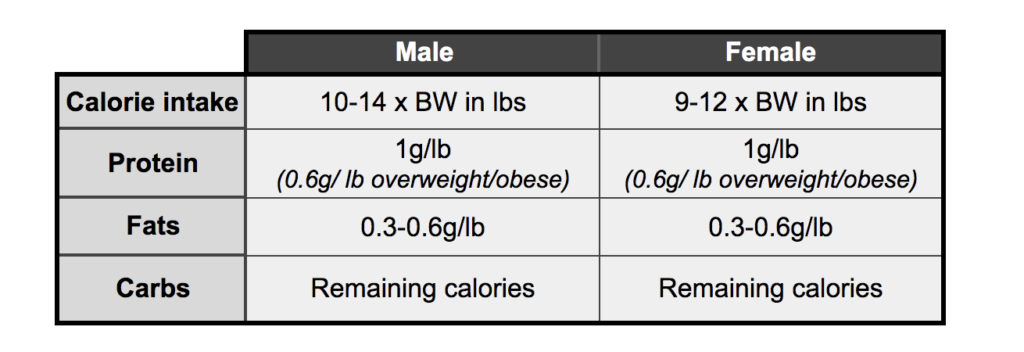
Remember: the biggest factor to your diet success is adherence. And autonomy is important. This is why I’ve provided you with guidelines on setting up your diet. How you distribute your macros is up to you.
Putting this all together
I know I just blasted your face off with a bunch of information, so now I’m going to illustrate how you’d take all of this and put it to use.
Meet Tim.
Tim’s let himself go a bit and over the years his weight (and body fat) has crept up. He currently weighs 190 lbs and according to his doctor:
Determined not to die and finally see his abs, our cuddly hero decides to sort his shit out.
So, remember: calories first.
Tim isn’t very active, working an office job sees him seated for 8+ hours a day. So we’ll go with the lower end of 10 as his multiplier.
To work out his calorie intake we’re going to take his body weight in lbs and multiply it by 10:
So, Tim’s calorie intake per day for fat loss is going to be 1900 Cals.
Next, we need to set his protein intake.
As I mentioned before, keep things simple and set protein intake to 1g/lb.
Tim’s daily protein intake will be 190g.
Carbs and fat?
Seeing that Tim has quite a bit of fat to lose, I’d generally keep his carb intake lower.
However, Tim enjoys his carbs and can’t see himself sticking to a low carb diet – and seeing that adherence is perhaps the biggest factor to diet success, we’re going to set his fat intake to 0.4g/lb to allow for enough carbs.
Tim’s daily fat intake will be 76g of fat per day.
This is where we are right now with Tim’s numbers:
All we need to work out now is his carb intake. To do that, we’re simply going to fill in the calories that remain after having set fat and protein with carbs.
Here’s how
Step 1: Work out the calories in Tim’s protein and fat totals.
To do this, multiply his protein intake by 4 (because there are 4 calories in a gram of protein) and multiply his fat intake by 9 (because there are 9 calories in a gram of fat).
So, it’ll look like this:
Step 2: Now that we know Tim is getting 760 calories from protein, and 684 calories from fat. We now need to add the two totals–protein and fat–together.
So, Tim is getting 1444 calories from his fat and protein intake.
Step 3: Subtract the fat and protein total (1444 calories) from his total required calorie intake (1900 calories):
So Tim has 456 calories left to distribute to carbs.
Step 4: Divide 456 by 4 (because there are 4 calories in a gram of carbohydrate) to get his carb intake in grams:
So, Tim’s total calorie and macronutrient intakes are:
WHAT SHOULD YOU EAT?
Now you know how much you should be eating, but you’re probably staring at these numbers and wondering: What the hell do I eat?
More on that in a second, but first: let’s quickly address two common dietary locutions.
1. “Just eat clean”: The problem with this line of thinking is that it creates a black and white, good and bad, neurotic mentality toward food. You should eat clean (good) while avoiding junk (bad). But the truth is that no food is inherently ‘bad’. Do some foods have more of a likelihood to be ‘bad’? Sure.
Hyperpalatable foods (that can trigger overeating) fall under this category. But, trigger foods can vary from person to person. What triggers one person to overeat will differ from somebody else. If you find you can stop eating at one or two slices of pizza but can’t control yourself around chocolate, does it make sense to avoid pizza? Of course not.
2. “If It Fits Your Macros”: This is the polar opposite of the eat clean maxim. Eat whatever you like as long as it “fits your macros”. While the intent behind this message was to prevent the neurotic mentality of clean eating, people bastardised the term and began eating all sorts of junk and weird food combinations to ‘hit their macros’.
While there isn’t one ‘best’ way to eat, here’s a general guideline:
➜ 70-80% of your diet should consist of whole, nutrient-rich foods and the remaining 20-30% can be filled with whatever you want.
Don’t be a militant dietary fuck nut running around telling people certain foods are “good” and certain foods are “bad”; this isn’t nursery, you’re not getting sent to the “naughty chair” because you ate a slice of pizza. Fuck, man, chill. But, at the same time, you shouldn’t be eating like a 10-year old let loose in Willy Wonka’s factory.
I want to believe most of you have some semblance of what ‘healthy’ foods are, but if you don’t please refer to the image below. You’ll see some foods should be limited while other foods should make up the bulk of your diet.
So the next time you’re wondering what to eat, just use the 80/20 rule. Aa
👍Eat this most of the time:
• Wholegrains
• Starchy vegetables (potatoes)
• Non-starchy vegetables
• Fruits
• Legumes
• Lean meats
• Fish (all kinds)
• Healthy fats like olive oil, nuts, avocado etc.
✋Eat this less of the time
Heavily processed foods like cake, candy, cereal, etc. You know what foods I’m talking about.
What you eat will also be influenced by your goal and personality type
• If you’re a Restrictor personality type: While no foods should be off-limits, some foods should be limited. For the restrictor personality type, foods you have trouble controlling yourself around should be kept out of the house. The more the temptation is there, the more likely you are to break down and overeat. This becomes even more important when you’re dieting and hunger and cravings are at an all-time high.
• If you’re in a caloric deficit: you’ll be better off choosing foods that are low in energy density and high in nutrient density. These foods will help keep you full when calories are low. Energy-dense foods like cereal, chocolate bars, ice cream, Pop-Tarts, etc. are less filling and thus less satiating. This is why you can eat a chocolate bar and be hungry again ten minutes later, while a calorically comparable meal filled with protein and veggies will keep you fuller for longer.
• Some people don’t want to ‘fit’ in tiny amounts of treats on a daily basis, and would rather have a day on the weekend where they can consume more calories. This is totally fine.
BUT AADAM, WHAT ABOUT SUPPLEMENTS?
The fitness world is rife with innumerable supplements claiming to help you burn fat and build muscle. Unfortunately, as sexy as these claims are, there are very few supplements that actually work and even then, these only work if your diet, training, and lifestyle are in order.
So, if you do have your diet, training, and lifestyle in order – here are some supplements that might be beneficial.

Most people should stick with the low end, unless you mainline caffeine on a daily basis, in which case go with the higher end. Just take the required amount 30-60 minutes before training.
But wait, I heard 15 minutes before training?
Caffeine is absorbed from the stomach within 15 to 45 minutes, however, it doesn’t reach it’s peak stimulatory effect until 30 to 70 minutes, so somewhere between 30-60 minutes before you work out will be most optimal.
The Blue Box of Read This Shit: learn all about caffeine here.
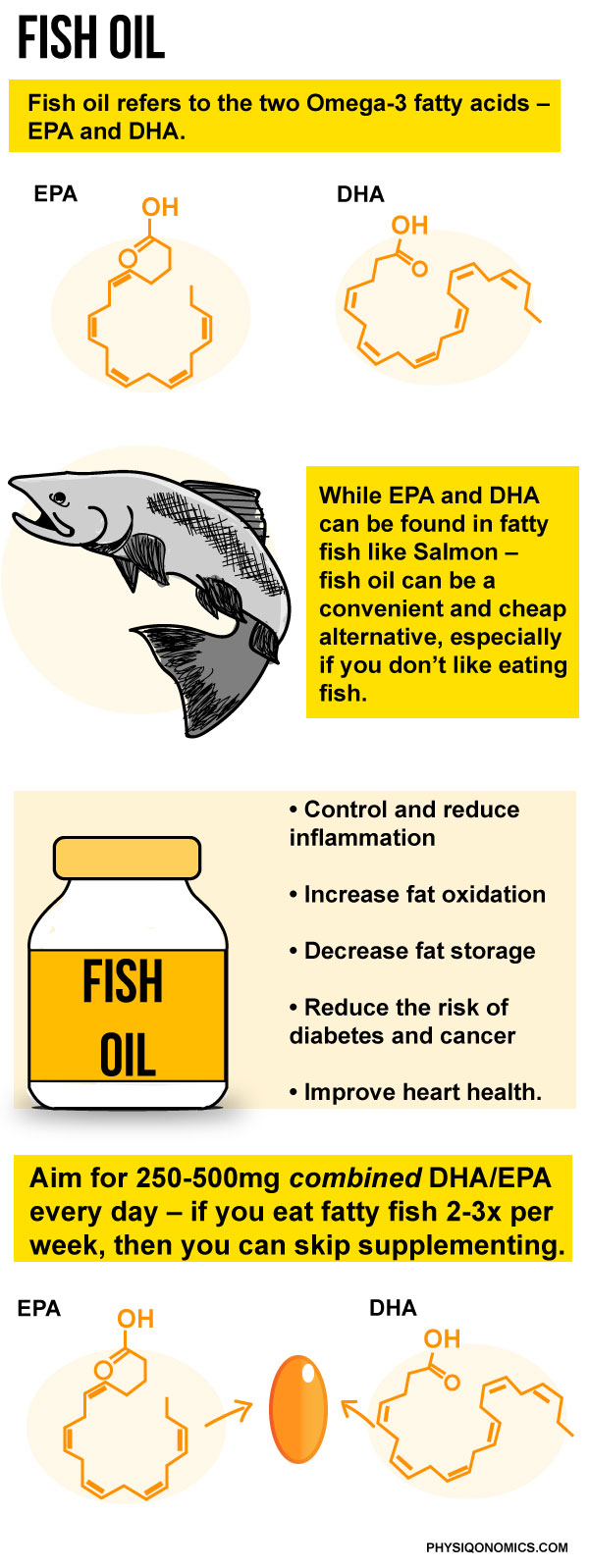

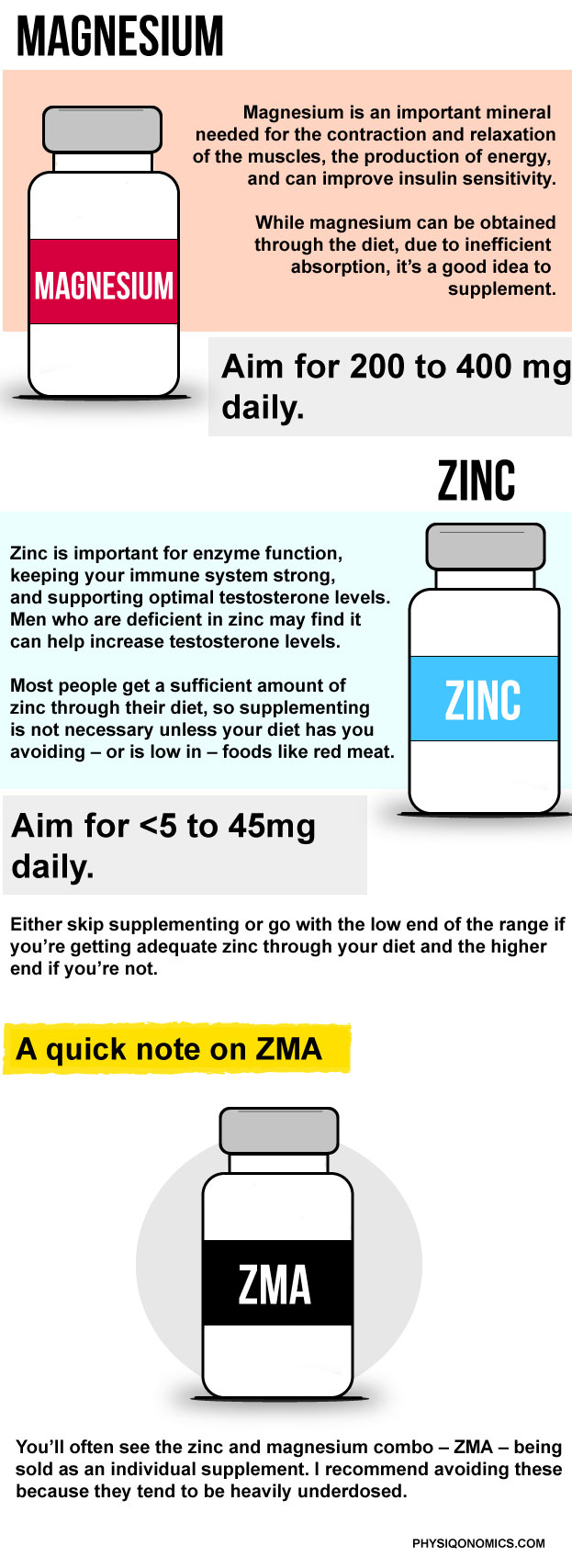
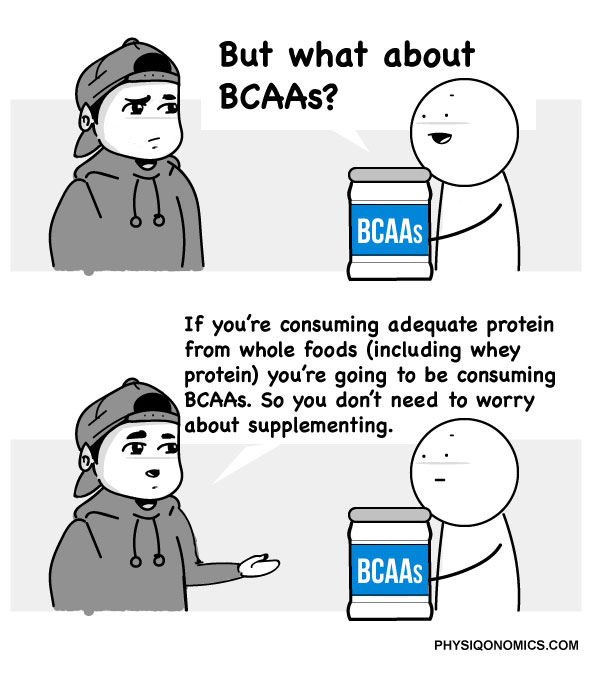
Also, this.
Multivitamins
Ok, I’m tired of drawing. Let’s wrap this shit up.
A multivitamin can be useful when you’re dieting and calories are low to help cover any nutritional deficiencies. Outside of that, don’t worry about them. Aa
MAKING ADJUSTMENTS TO THE DIET
Every diet will need to be adjusted as you lose weight and get leaner. Here are some suggestions on how to do that.
On starting your diet don’t make any adjustments for the first 4 weeks. The body takes some time to ‘catch up’ to the deficit and waiting 4 weeks from when you first set the deficit will allow enough time for you to gauge what’s happening.
Alright. Let’s assume you’ve done all of the above – you’ve set the deficit, waited 4 weeks, and fat loss really has come to a halt. How do you make the adjustment?
Easy: Reduce calorie intake by 5-10%.
So, if you’re starting calorie intake was 2500 calories, you’d reduce this by 125-250 calories.
Where should the adjustments come from?
This is where people get confused: should you cut carbs, fats, or protein?
- Don’t touch protein intake or you’ll die. Ok, you won’t but leave protein as it is.
Carbs or fats?
This is going to be your call. But here are some suggestions:
- If you’re following a higher carb diet, reduce carb intake. This reduction would be anywhere between 30 to 60 grams of carbs (1 gram of carbohydrate has 4 calories. 125/4 = ~30, 250/4 = ~60) Aa
- If you’re following a higher fat or ketogenic diet, reduce fat intake. There are 9 calories in a gram of fat, so the reduction would be anywhere between 10 to 30 grams of fat.
After your first adjustment, keep an eye on your weekly average weight, measurements, and progress photos. Wait 2-3 weeks, If things look like they’re stalling, make another 5-10% reduction.
The Blue Box of Read This Shit: if you want to learn more about how to track your progress, read point number 2 in this article.
HOW FAST CAN YOU LOSE FAT?
Here’s the thing: You can’t force fat loss. The only thing you can do is coax your body to drop fat by eating in a calorie deficit and complementing it with training. So, firstly:
Calm the fuck down and be patient. You didn’t get out of shape in a week, you’re not getting in shape in a week. The people who have this “fast fat loss” mentality are also the ones who tend to gain it back after the diet ends, or quit entirely after a few weeks. Not because aggressive dieting doesn’t work, but because this mentality encourages the use of fad diets that, a) won’t be sustainable in the long-term, and b) doesn’t help you build the habits that allow you to maintain the loss in the long run. Aa
Now that’s out the way, the second thing we should probably discuss is how fast you should be expecting to lose fat. This depends on how much fat you have to lose. The higher your starting levels of body fat, the faster you can expect to lose; conversely, the leaner you start, a slower rate of loss will be best to minimise muscle and strength loss.
With that in mind:
➜ Set fat loss targets between 0.5 – 1% of your total body weight per week.
Setting fat loss targets as a percentage means the rate of loss automatically scales with your body weight.
For example:
WHAT ABOUT TRAINING FOR FAT LOSS?
Need a training program?
Drop your email below and I’ll send you a simple 3-day beginner strength program to help you get started.
Fat loss is all about efficiency. You shouldn’t be “training for fat loss” because you can’t out-train your diet. Rather, you want to train for muscle and strength gain and retention, while letting your calorie deficit handle the “fat burning”.
And this is where most go wrong. When it comes to losing body fat, there are some things that take precedence over other things as illustrated in this image.
You’ll note that strength training comes before cardio in this hierarchy.
Why though?
For the reasons I’m about to outline below in an easy-to-read, bullet-point format.
- If you want to lose fat and change the look of your physique, you need to lift weights. Note I said you need to, not, “If you want to”. The muscle definition is going to come through progressive resistance training. So make that the focus of your training.
- The ‘lean’, ‘toned’, ‘ripped’ look is predicated on how much muscle you build and retain and strength training will help you preserve muscle during a calorie deficit.
- You can’t “spot reduce fat” (selectively lose fat from a certain place on your body.) But you can “spot increase muscle” (selectively increase muscle on certain parts of your body). This, in turn, will help you “tighten up”.
- The stronger you are – increased muscle and connective tissue strength and bone mineral density – the more resilient you become to injuries. Sure, this isn’t directly linked to fat loss, but, I mean, do you want to die? Exactly.
- If you’re really unfit or have a lot of fat to lose, cardio – like running – can be difficult and put a lot of stress on your knees. And for most people, it won’t be sustainable.
- I understand this is perhaps because of my inherent bias, but strength training tends to be more enjoyable, and as you master complex movements and watch your lift numbers go up, this can act as a powerful motivator.
Sooo…cardio’s bad?
No. That’s not what I’m saying. Cardio isn’t bad–quite the opposite.
Everyone should do some form of cardio; swimming, walking, running, hiking, playing a sport, whatever. The point I’m trying to impress upon you is that most people resort to ‘cardio’ when trying to lose fat but it’s of the least importance when changing your body composition is the goal.
Wait, WTF is NEAT?
NEAT stands for Non-Exercise Activity Thermogenesis and is all the activity that isn’t intentional exercise; fidgeting, walking, playing with your dog, etc.
Ok, why should I give a fuck?
NEAT is one of the most underrated tools at your disposal if you’re wanting to lose fat. Let me explain why.
There are 24 hours in a day (actually it’s 23 hours and 56 minutes, but I digress), most people who, uh, you know, have a life will only be training for around an hour a day.
That’s ~5% of your day.
Now, there are 168 hours in one week. If someone trains for an hour, 3-5x per week, that’s 3-5 hours of intentional exercise versus 163-165 hours of no exercise.
I’m sure we can all agree that what we do in those 163-165 hours is going to have a far larger influence on our fat loss than what we do in the 3-5 hours in the gym.
And that’s where NEAT comes in.
The graph below shows the difference in calories expended via different jobs. 4
Note how much of a difference there is in calorie expenditure between being seated all day (seated work – no option of moving) and standing work.
Point: simply being more active throughout the day – walking, interspersing periods of sitting and standing, light stretching etc. add up – everything counts. A really simple way to do this is to aim for 10k steps per day.
The Blue Box of Read This Shit: I wrote an entire article on how to program your strength training while in a calorie deficit to prevent muscle and strength loss, you can read that by clicking here.
FREQUENTLY ASKED FAT LOSS QUESTIONS
Here are my answers to a number of questions I get asked related to fat loss. Click the dropdown arrow next to each question and it’ll expand with my response.
-
Do I need to eat six times a day to stoke my metabolism?
Out of the many nutrition myths that are prevalent today, this is perhaps one of the most pervasive.
The claim: Eating more frequent meals spread throughout the day will keep your metabolism ‘stoked’ and in turn will help you burn more fat (and store less fat).Whether intentional or not, this idea stems from a misunderstanding of what’s actually going on. When you eat there is, in fact, an increase in metabolic rate but this is due to the thermic effect of food. The Thermic Effect of Food (TEF) is the number of calories your body burns digesting the food from the meal you ate.However, while there is an increase in metabolism via TEF when you eat a meal, the idea that this increase is meaningful enough to burn fat (and/or prevent fat storage as we’ll discuss later) is not only wrong but can lead to people gaining even more weight.What, why?The Thermic Effect of Food only equates to ~10% of total calorie expenditure and this amount stays the same regardless of the number of meals a person eats.The difference is that the person eating more frequently will see more ‘spikes’ in metabolism throughout the day due to TEF while someone eating less frequently will see fewer spikes throughout the day.Like so.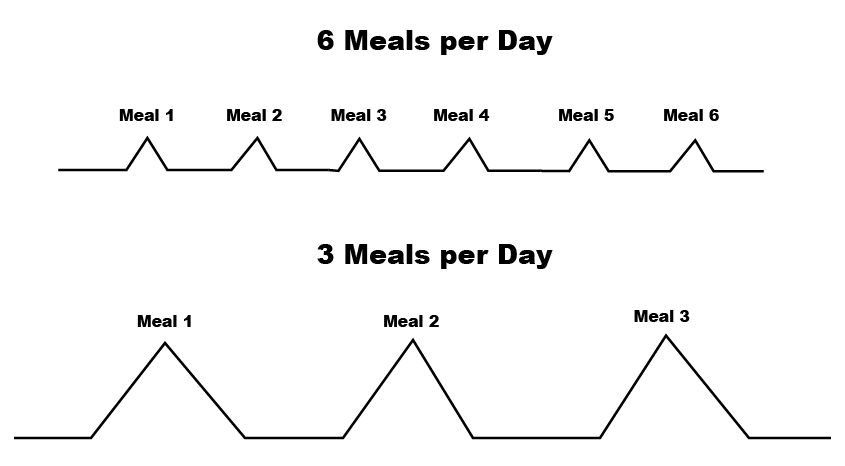
More frequent eating will cause more spikes due to TEF, while less frequent eating will cause fewer, yet larger spikes. But, there’s somewhat of a paradox to the 6 small meals for better fat loss claim. Here’s why.Let’s assume we have three different people consuming 2000 calories per day split into three different meal frequencies. One consumes the 2000 calories in 5 meals per day; one consumes the 2000 calories in 3 meals per day; one consumes the 2000 calories in 2 meals per day.We can represent this in a graph like so.– Green: 5 meals per day
– Red: 3 meals per day
– Blue: 2 meals per dayNotice that the blue bar – 2 meals per day – actually increases your metabolic rate the most, requiring 100 cals to digest the food. The red bar – 3 meals – comes in second, requiring 66 cals. And, contrary to the popular claim, 5 small meals actually comes in last, requiring the least number of calories to digest the food.
So, paradoxically, eating larger, less frequent meals “speeds up your metabolism” more than “small frequent meals”.
Point: Pick a meal frequency that suits you, at a minimum three meals is ideal, but if you prefer 2, or 4, or 5 meals per day – cool. Do that. The number of meals you eat won’t make a difference, so pick the meal frequency that suits you and your lifestyle best.
-
Is sugar toxic?
When we talk about ‘toxicity’ we’re talking about how poisonous a substance is to a biological organism, like humans. Researchers measure acute toxicity by using this thing called the LD50 (which is nerd talk for “the lethal dose to kill 50% of the test subjects”).
OH, don’t worry, they don’t test this stuff on humans because, aside from violating like a billion human rights laws, it’d be pretty fucking inhumane. They use rats because fuck rats.
So anyway, as I was saying LD50.
There’s a saying amongst Toxicologists that “the dose makes the poison.” Simply, everything can kill you in a large enough dose. No, really. Here’re some examples of everyday foods that can be toxic if consumed in enough quantities.
– 70 cups of coffee
– 17 (500ml) bottles of water
– 40 bars of Dairy Milk
So, can sugar be toxic? Sure, if you go absolutely crazy and consume like 50 (100g) bags of Haribos, or 164 bananas, or 31 small McDonald’s chocolate milkshakes in one sitting.
Otherwise, no.
-
Will aspartame kill me/stop me from losing fat/make me gain fat/spike my insulin/steal my significant other?
Probably not. See this.
-
My friend Becky told me I have a slow metabolism. Do I?
a) You don’t.
b) Stop listening to Becky.
-
I think I’m in starvation mode.
You are certainly not.
-
Will eating late at night make me fat?
If eating late at night sees you go into a calorie surplus, yes. Otherwise no.
-
What’s your opinion on waist trainers?

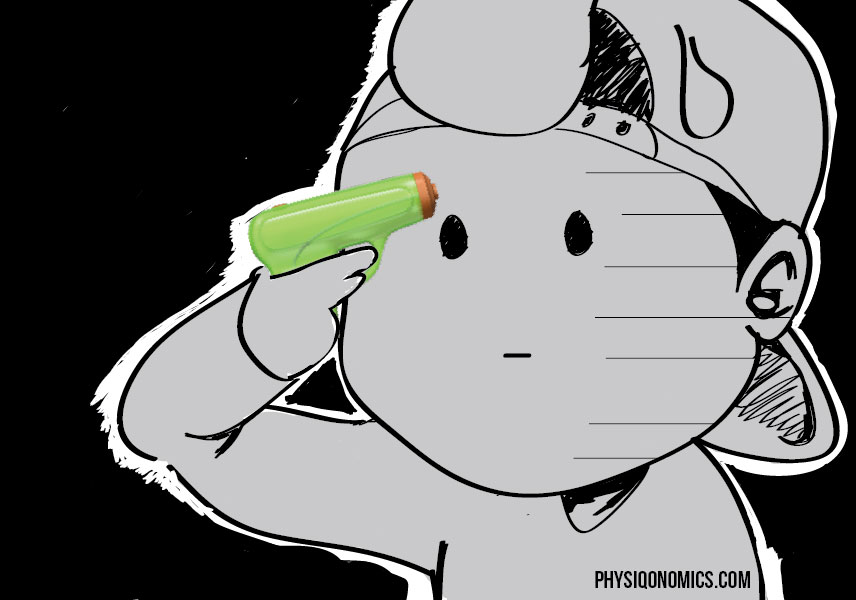
-
I want to lose fat, build muscle, do CrossFit, run a marathon, swim the Atlantic, and climb Mount Everest, I’m so confused.
So am I.
-
Is too much protein bad for my kidneys?
If your kidneys are healthy, no, but with that said, there’s no need to consume more protein than what I’ve outlined in this article.
Also, see this.
-
Will eating more fat make me burn fat?
This is one of those, “It’s-technically-right-but-still-wrong” type things. If dietary fat is the primary source of your calorie intake (like, say you’re in a state of ketosis) then yes, your body will primarily use ‘fat’ as it’s go-to fuel source; ergo, your body is ‘burning fat’ because you’re eating more fat.
However: ‘Fat-burning’ does not equate to ‘body fat’ burning.
Your body is constantly storing and burning fat in a day, and it’s the long term balance – over weeks – that will dictate whether you’re losing or gaining body fat.
If the amount of fat you burn stays the same as the amount of fat you store over the long term: body fat remains the same.
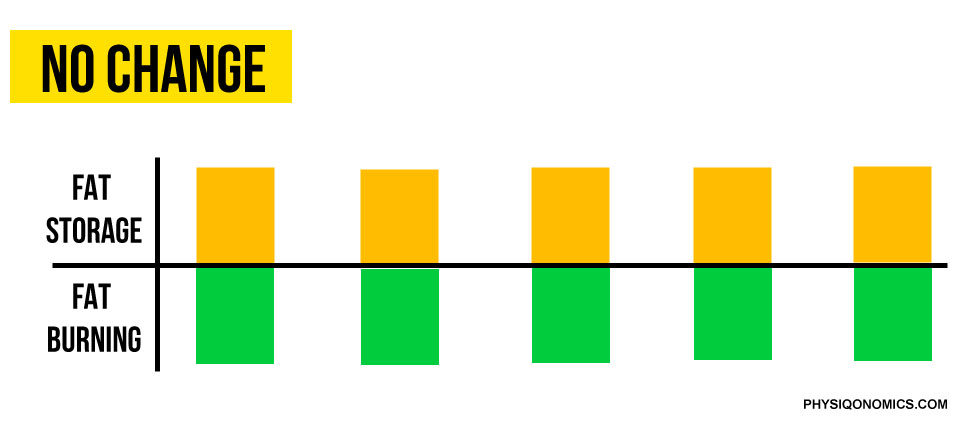
If the amount of fat you burn over an extended period is less than the amount you store, you’ll lose fat.

If the amount of fat you store exceeds the amount of fat you burn, you’ll gain fat.
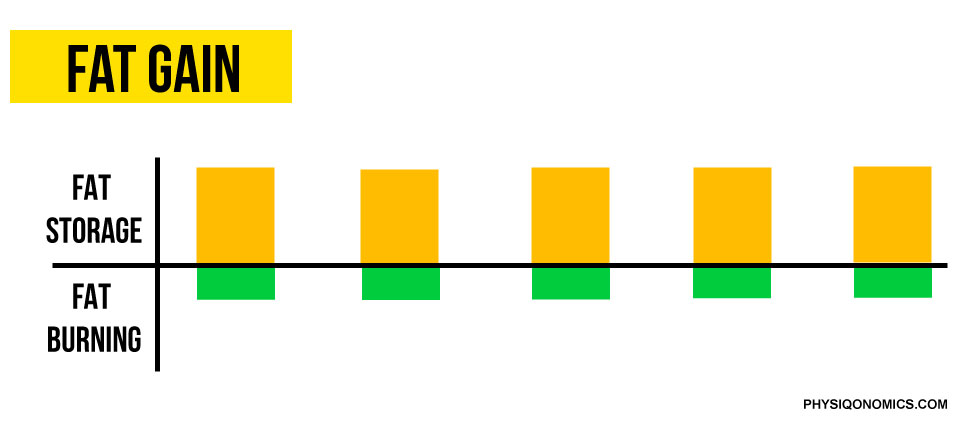
This is referred to as ‘fat balance’ and is, surprise surprise, dictated by your total calorie intake. So if you’re pouring heaps of butter on everything in the hopes of losing body fat – sorry to break it to you, but you’re fucking up.
-
I’m dieting and I’m hungry – what can I do?
Here are some tips:
Increase fibre intake – One of the ways our brain determines fullness is the physical stretching of the stomach. Foods high in fibre, such as vegetables and whole-grains, help stretch out the stomach and signal to the brain that you’re full. Fibre also tends to slow down digestion – when you add in fibre to your meals, the rate at which the body digests the food takes longer. The longer this food sits in your stomach the fuller you’ll feel.
Set a consistent meal frequency – Ghrelin, the hunger hormone, controls when you get hungry. Fortunately, ghrelin can also be ‘trained’. Training yourself to eat at set times will keep Ghrelin consistent and will create consistent hunger patterns – you’ll get hungry at similar times in the day – this will reduce the risk of falling off plan.
Skip breakfast – Restricting your eating window to a shorter time frame by skipping breakfast will mean you can eat larger meals which in turn will help keep you full, both mentally, and physically. While people freak out at the idea of skipping breakfast, it isn’t the most important meal of the day, and it won’t ruin your metabolism. Instead of eating 4-5 small meals at 200 calories, eating 3 large meals at 500 calories will result in better satiety.
Don’t be extremely restrictive with your diet – What happens if I tell you that you can’t have something? You’re more likely to want that thing, right? This is why unnecessarily restrictive diets don’t last long. Don’t needlessly remove foods from your diet.
But, restrict some things – No, I’m not contradicting myself, fuck you. Some foods trigger cravings and can cause you to overeat. If you have foods like that in the house, you will be best served to remove them, and the temptation that comes with them.
Diet drinks – As I mentioned earlier, diet drinks can be a great aid during low-calorie periods. Just make sure you’re keeping a tab on these – while you would need to drink a lot (like, really, A LOT) of diet drinks for them to even have the potential to be harmful to health, the main reason for limiting intake is due to hedonic adaptation.
Coffee – Coffee has great appetite suppressant effects and has also been shown to improve health. Is there anything coffee can’t do? No, it’s basically Jesus in a cup.
-
I’m tracking everything and eating healthy and exercising like a gazillion times a week, AND I STILL CAN’T LOSE FAT. WHAT’S WRONG!?
-
My friend Becky said if I don’t eat breakfast I’ll implode…
What the f – what did I say about listening to Becky?
You don’t have to eat breakfast. Look, let me bring in my not really friend Marion Nestle to explain:
Many—if not most—studies demonstrating that breakfast eaters are healthier and manage weight better than non-breakfast eaters were sponsored by Kellogg or other breakfast cereal companies whose businesses depend on people believing that breakfast means ready-to-eat cereal.
Independently funded studies tend to show that any eating pattern can promote health if it provides vegetables and fruits, balances calories, and does not include much junk food.”
When you eat matters far less than how much you eat. If you wake up and are feeling hungry, feel free to have breakfast, if you aren’t hungry in the mornings, skip breakfast.
-
Is fasted training better for fat loss?
No, see this.
-
Will eating more fat make me burn fat?
This is one of those, “It’s-technically-right-but-still-wrong” type things. If dietary fat is the primary source of your calorie intake (like, say you’re in a state of ketosis) then yes, your body will primarily use ‘fat’ as it’s go-to fuel source; ergo, your body is ‘burning fat’ because you’re eating more fat.
However: ‘Fat-burning’ does not equate to ‘body fat’ burning.
Your body is constantly storing and burning fat in a day, and it’s the long term balance – over weeks – that will dictate whether you’re losing or gaining body fat.
If the amount of fat you burn stays the same as the amount of fat you store over the long term: body fat remains the same.

If the amount of fat you burn over an extended period is less than the amount you store, you’ll lose fat.

If the amount of fat you store exceeds the amount of fat you burn, you’ll gain fat.

This is referred to as ‘fat balance’ and is, surprise surprise, dictated by your total calorie intake. So if you’re pouring heaps of butter on everything in the hopes of losing body fat – sorry to break it to you, but you’re fucking up.
-
I’m dieting and I’m hungry – what can I do?
Here are some tips:
Increase fibre intake – One of the ways our brain determines fullness is the physical stretching of the stomach. Foods high in fibre, such as vegetables and whole-grains, help stretch out the stomach and signal to the brain that you’re full. Fibre also tends to slow down digestion – when you add in fibre to your meals, the rate at which the body digests the food takes longer. The longer this food sits in your stomach the fuller you’ll feel.
Set a consistent meal frequency – Ghrelin, the hunger hormone, controls when you get hungry. Fortunately, ghrelin can also be ‘trained’. Training yourself to eat at set times will keep Ghrelin consistent and will create consistent hunger patterns – you’ll get hungry at similar times in the day – this will reduce the risk of falling off plan.
Skip breakfast – Restricting your eating window to a shorter time frame by skipping breakfast will mean you can eat larger meals which in turn will help keep you full, both mentally, and physically. While people freak out at the idea of skipping breakfast, it isn’t the most important meal of the day, and it won’t ruin your metabolism. Instead of eating 4-5 small meals at 200 calories, eating 3 large meals at 500 calories will result in better satiety.
Don’t be extremely restrictive with your diet – What happens if I tell you that you can’t have something? You’re more likely to want that thing, right? This is why unnecessarily restrictive diets don’t last long. Don’t needlessly remove foods from your diet.
But, restrict some things – No, I’m not contradicting myself, fuck you. Some foods trigger cravings and can cause you to overeat. If you have foods like that in the house, you will be best served to remove them, and the temptation that comes with them.
Diet drinks – As I mentioned earlier, diet drinks can be a great aid during low-calorie periods. Just make sure you’re keeping a tab on these – while you would need to drink a lot (like, really, A LOT) of diet drinks for them to even have the potential to be harmful to health, the main reason for limiting intake is due to hedonic adaptation.
Coffee – Coffee has great appetite suppressant effects and has also been shown to improve health. Is there anything coffee can’t do? No, it’s basically Jesus in a cup.
-
I’m tracking everything and eating healthy and exercising like a gazillion times a week, AND I STILL CAN’T LOSE FAT. WHAT’S WRONG!?
-
My friend Becky said if I don’t eat breakfast I’ll implode…
What the f – what did I say about listening to Becky?
You don’t have to eat breakfast. Look, let me bring in my not really friend Marion Nestle to explain:
Many—if not most—studies demonstrating that breakfast eaters are healthier and manage weight better than non-breakfast eaters were sponsored by Kellogg or other breakfast cereal companies whose businesses depend on people believing that breakfast means ready-to-eat cereal.
Independently funded studies tend to show that any eating pattern can promote health if it provides vegetables and fruits, balances calories, and does not include much junk food.”
When you eat matters far less than how much you eat. If you wake up and are feeling hungry, feel free to have breakfast, if you aren’t hungry in the mornings, skip breakfast.
-
Is fasted training better for fat loss?
No, see this.
Ok, I think that’s everything. We’re done. Thank fuck because I’m hungry – I’m gonna go make a sandwich.
WHAT NEXT?
This article has been viewed over 1 million times since its first publication in 2017, and I’ve received thousands of emails from people telling me it’s changed their life.
But this stuff isn’t going to work if you don’t put this information to use. So don’t just read this, start implementing all the information today.
If you need more structured help, here are some things worth checking out:
- Check out Physiqonomics PLTNM–the all-in-one platform that takes all the guesswork out of the body transformation equation so whether you want to lose fat, tone up those trouble areas, build lean muscle, or get stronger–PLTNM has you covered.
- If you need personalised help with your goals–work with me through my online coaching program and let me take care of your training and nutrition. You can get more details and apply here.
- Or, if you want more content like this, sign up to my weekly emails. I send one email every week, and my readers tell me they’re the best fitness emails on the internet. Subscribe and decide for yourself.
